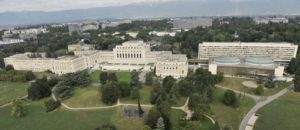Soft power is the ability for a country to have international influence through means other than the threat of military action or aggressive economic policy (i.e. hard power). How do the arts and cultural diplomacy work as soft power? What ends are being pursued, and how do the arts serve as a means to that end?
Researchers through King’s College London conducted a study, with extensive interviews of diplomats, at the United Nations Office at Geneva (UNOG). This is a fascinating paper that I will be sure to add to future syllabi in courses on cultural policy. To summarize the approach (from p. 08):
This enquiry focuses on the work of diplomats at UNOG. Its approach is predicated on the belief that diplomats are key agents in the service of Soft Power and Cultural Diplomacy. They are both the delivery channel for their government’s policies, as well as the embodiment of national culture and values, regardless of where they happen to be located or which country they serve. Although the activities of diplomats do not command the same attention or resources as conventional cultural levers of Soft Power (typically language schools or the export and promotion of film, music, publishing, education and other cultural forms) and their work is not always in the public eye, they offer a tantalising glimpse into the realities of how Soft Power is practically manifested and how its objectives are achieved.
Diplomats offer an interesting subject. They are hired, and expected to perform, with the strictest adherence to their assigned mission, which is representing and advancing their government’s interest as defined by the executive branch. It is not a role calling for ‘policy entrepreneurship’, and there is a reason why the foreign service is an aspect of the state absent from most discussions of contracting-out tasks to private interests (I’ve always liked this analysis by Oliver Williamson). And what we find at UNOG (if I can offer the briefest summary – the whole paper is well worth reading) is art presentation and events chosen with caution, and with an eye to advancing national interests, in terms of conveying a positive international image of the host country, and of facilitating discussion between diplomats that will advance national goals. There is great faith that it “works”, although the evidence is, itself, “soft”.
The ultimate finding in the report is that “culture is used to preserve and express hard political power.” (p. 26):
This is in stark contrast to the Cultural Diplomacy literature, which casts the use of culture in diplomacy as something benign, informed by an almost ‘gentlemanly’ conduct and operating in a distinct realm, separate and removed from politics. A key finding in this enquiry is that cultural spaces are loaded with political meaning and they can be the site of simmering political tensions and rivalries, sometimes sparked or made apparent by cultural activity.
But the rituals behind cultural diplomacy leave me wondering about its effects. That cultural diplomacy is a soft power approach to achieve hard goals is known by all participants in this game. We “see through” attempts by a nation to use carefully chosen works of art to convey a particular message from the host country; certainly anybody with a post at UNOG does, as I imagine do the citizens of Geneva. The impact of participating in the ritual of cultural events might simply be to convey the signal: we are players in this game. (The authors cite David Kertzer’s Rituals, Politics and Power as a possible way into the question). I do not know, and I’ll commend the authors of the study for not overreaching in terms of drawing any firm conclusions about what lies inside the black box of soft power.
When I first came to start reading about soft power and the arts, questions I had in mind were whether people would have biases in terms of perceiving their home country’s soft power, and on whether there might be something insidious about using the arts to try to shape the perceptions, and decisions, of other countries through this means. In the end I was left wondering about how important soft power actually is in terms of real effects. That diplomats use cultural events to provide backdrop to discussions facilitating harder negotiations I can understand. But what is the impact of the art itself? Does the recent success of South Korean pop music, or “Nordic noir” television, truly have international impact beyond their being a source of export earnings? Or, if soft power has impact at all, is art a relatively minor part, compared to the perception of the nation’s democratic institutions and policies? The best we can hope for is a range of approaches to the question – no one study can possibly answer this for us – and this paper, and the recent work from the University of Edinburgh, are wonderful prompts to further study.


Leave a Reply